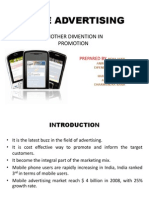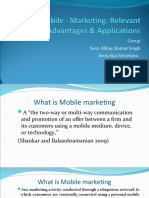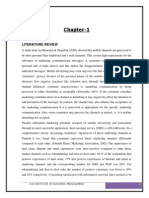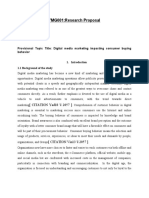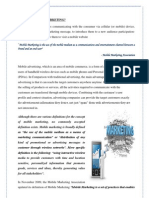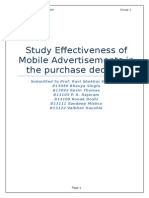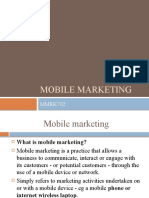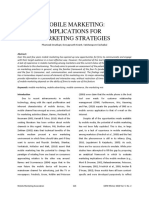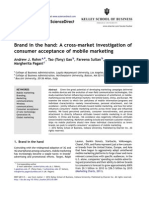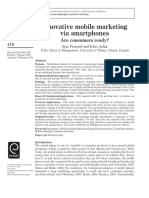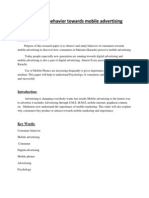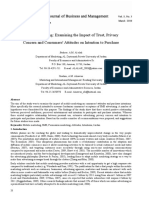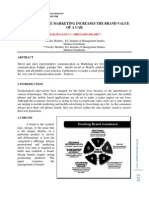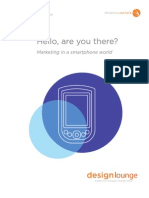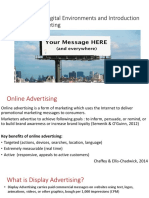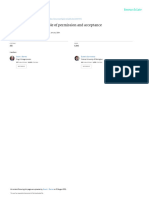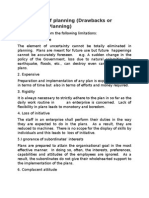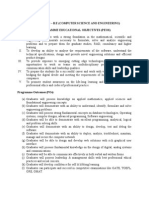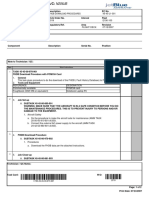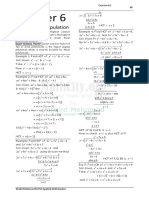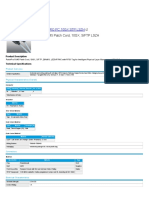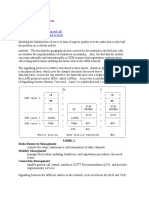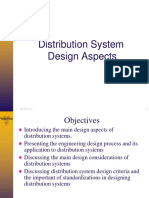MOBILE MARKETING
Introduction
The end of the 20th century and the beginning of 21st were characterized by rapid
developments of communication tools. The e-commerce hype has barely subsided, and the focus
has already moved on to the mobile Internet. The new technology changed the world by
revolutionizing communication: Mobile computing technology as a communication tool was
initially limited to voice telephony. However, due to digitalization and the consolidation of
telecommunication networks and Internet technology, mobile devices have evolved to full-scale
Internet-enabled computers. The convergence of those technologies provides endless possibilities
for mobile computing applications and usage.
Mobile marketing is defined in this paper as advertising or marketing related messages
sent to a mobile phone. The emphasis of the marketing communication is via short message
services (SMS) but can also include emails accessed by mobile phones and multi-media
messaging services (MMS). Mobile marketing (m-marketing) is still in its infancy but is
expected to grow rapidly in the near future However, researchers are still unclear as to the key
issues that are likely to impact on the success of m-marketing and the levels of adoption by
consumers.
Mobile marketing is becoming increasingly important in retailing. Due to the time
sensitive and location-sensitive nature of the mobile medium and devices, mobile marketing has
the potential to change the paradigm of retailing. 3 The traditional model of retailing is based on
consumers entering the retailing environment, making location the primary source of competitive
advantage. Mobile marketing is turning this paradigm on its head. Retailers can now enter the
consumer’s environment through the mobile device, and, because the mobile device stays with
the consumer, the retailer can be anywhere, anytime.
The mobility and the personal nature of the mobile device distinguish it from other
electronic devices such as the television (TV) and the personal computer (PC) and other
Channels, with important implications for retailers. Unlike TV and PC, mobile device is a
constant companion to the consumer. It is regarded as a personal accessory, is generally not
shared, and potentially acts as a gateway to an intimate relationship between the consumer and
the retailer. Furthermore, because the device is portable, it is an ideal supplementary channel for
virtual e-tailing as well as physical retailing.4 Retailers can push sales promotions or fulfillment
1
� MOBILE MARKETING
updates to consumers through the mobile channel for the consumers to access instantly. In the
traditional channel, a bricks-and-mortar retailer can interact with a potential customer only when
the customer is in the vicinity of the store
Review of Literature
Mobile Marketing is the use of the mobile medium as a communications and
entertainment channel between a brand and an end-user. It is a new addition to the media mix,
with great opportunities for direct interaction with customers and cost-effective data collection.
Why M-Marketing
• Interactivity – Empowers to engage the consumer in a dialogue.
• Anywhere/Anytime – Mobile is always with in reach.
• High reach – Over 100 million mobile subscribers in India
• Personal – Highly effective as communication to an individual
• Viral – Fun factor allows for epidemic phenomenon
• Targeted – Specific message can be conveyed based on the consumer profile
• Digital – A medium allowing for deep campaign analysis
• Cost – Significantly economical than any other media.
Mobile marketing is the only marketing medium that creates a personal channel enabling
spontaneous, direct, interactive and/or targeted communications, any time, any place.
M-Marketing Applications
• Product launch
• Sales promotion
• Thematic Ad based promotions
• Brand awareness
• Event promotion
• Interactive TV
• Location based marketing campaigns
• Mobile coupons
• Market research
• Feedback
• Contests
• Branded adver-gaming
2
� MOBILE MARKETING
• Loyalty programme
M-Marketing services
Value first provides end-to-end services required to execute a mobile marketing
campaign. The services can be classified as:
Targeted Marketing –
Custom text and picture messages depending on the user profile are pushed/ send to the
target audience. Costs involved are the costs of the lists plus the costs for sending the message.
Messages can be created and pushed/ send on the basis of pre-configured business rules.
Short-code services –
A 5 digit number accessible by subscribers of any mobile operator is used to run
campaigns, receive response from consumers and generate an opt-in list. Used when the
campaign is targeted at prospective customers and/or the recall value is important.
Long-code services –
A 10 digit virtual/real mobile number which has to be rented out from an operator – work
across all operators but cheaper than the Short Code. Has lower recall but potential for high
usage in a closed user environment e.g. to interact with members of a loyalty card scheme.
Conceptual positioning of mobile marketing
Research on the adoption m-marketing falls into two categories. The first category takes
an application perspective. Within this stream of research, the distinctive features of the
application area are examined and brought together in various research models. These features
include such factors as consumer and industry technology, location awareness, personalization,
benefits of m-advertising and fears in relation to m-advertising. All of these factors are likely to
impact on consumer adoption of m-marketing. A similar approach is taken by Krishnamurthy
who identifies the key factors impacting on m-marketing adoption as message relevance,
personalization, privacy costs, message processing costs and monetary benefits.
The second m-marketing research category uses established information technology
adoption frameworks to structure the studies, for example Barnes and Huff (2003) use Rogers’
innovation and diffusion theory (1995) to examine the diffusion of Internet access via mobile
phones (2003). Studies related to advertising and marketing are closely associated with consumer
attitudes. Attitude in this context has been defined as a learned predisposition of human beings
3
� MOBILE MARKETING
(Fishbein, 1967). Using a form of Theory of Reasoned Action (TRA) Tsang, Ho and Liang
(2004) examine the link between attitude, intention and behaviour in relation to mmarketing.
In their model entertainment, informativeness, irritation and credibility are seen to shape
attitudes in addition to permission which has a major impact. The availability of incentives, such
as free calls, impacts on intention to receive m-marketing for certain attitudes. Intention is
directly related to behaviour in relation to m-marketing. Their study findings indicate that
consumers have a negative attitude towards mobile advertising unless they have consented to it.
All four attributes of mobile advertising impact significantly on attitude towards mobile
advertising. Attitude was significantly correlated to intention with incentives also positively
impacting on intention. There is a strong correlation between intention and behaviour. This study
was conducted in Taiwan with a large percentage of respondents regularly using SMS, although
it is unclear from the results presented the extent to which respondents had received mobile
advertising.
Intention and use behaviour has been heavily researched in IS with a number of models
being available. The study by Venkatesh et al. synthesises the main models in order to provide a
unified view of user acceptance The unified model identifies determinants and moderators
related to intention and suggests intention is a predictor of use behaviour. Four factors impact on
intention and usage: performance expectancy, effort expectancy, social influence and facilitating
conditions. The key moderators are gender, age, experience and voluntariness of use.
Interestingly, attitude was considered to be in overlap with performance and effort expectancies.
The non-significance of attitude in the presence of these two other constructs has been supported
in a number of other studies. The unified model was found in empirical studies to be a substantial
improvement on any of the other earlier models.
Mobile Consumer Activities
Retail consumers use the mobile for a variety of activities relating to shopping in the
retail environment.7 These activities include creating a shopping list, searching for the right
products and prices, querying retailers, comparing different items, purchasing items, and
indulging in post-purchase activities. Not all consumers are involved in all of these mobile
activities A customer experience8 found that although 91 percent of online retail shoppers have a
mobile phone, only 29 percent of online shoppers used a mobile phone as part of the shopping
experience, and, the majority of shoppers who used a mobile handset, did not make heavy of use
4
� MOBILE MARKETING
of retailer-originated mobile applications. The study also showed that 72 percent of those who
did use a mobile phone, 7 For used it to ask someone about a particular product; 40 percent of
those who used the mobile phone used it to send a photo of the product; 24 percent of those who
used the mobile phone used it to compare prices on the Internet or mobile Web; and 15 percent
of those who used the mobile phone used it to read product reviews on the Internet or mobile
Web. The study also found that people who use mobile phones while shopping are not more
loyal, more satisfied, or more likely to recommend top retailers’ websites than are other
shoppers. In fact, of the behaviors studied, only one was found to be different for this group:
greater likelihood to purchase offline. The effects of the mobile on consumer activities are
moderated by mobile consumer segments and by the enablers and inhibitors of mobile adoption.
Research Design and Methodology
Although the unified model of user acceptance was found to be an improvement on other
models of user acceptance there are a number of problems in directly applying it to consumer use
of m-marketing. In particular, effort expectancy as a construct is aimed at systems that involve a
certain amount of learning and where usability is an issue. However, in terms of m-marketing
this can be replaced constructs that test the cognitive load on users through length, readability
and number of messages received. Social influence is an important factor when examining
adoption of information technology since it considers the role of senior management. Facilitating
conditions is related to having the knowledge and resources to use the system and is not directly
applicable to m-marketing since those that have a mobile phone could at least receive SMS. The
constructs that are relevant to m-marketing. Performance from the unified model is equivalent to
the benefits of receiving m-marketing messages, we have included incentives as part of the
benefits. Permission is tested as a separate construct impacting on intention behaviour . Due to
m-marketing not being widely used in India we have not gathered data on usage behaviour. In
our pilot of the survey we found that respondents had little experience of m-marketing, many had
only received a small number of messages, mainly from their telecommunications carrier, over
the past year and could not remember fully how they responded to those. As this is the case, we
determine intention and this implies usage behaviour as found in other studies
Mobile Marketing Practices
The mobile consumer activities discussed earlier lead to several mobile marketing
practices or initiatives by the retailer. To satisfy customer needs profitably, given consumer
5
� MOBILE MARKETING
attitudes and behaviors and their differences across segments with regard to the mobile, retailers
engage in a number of mobile marketing practices. These practices include: mobile website
creation and maintenance, mobile emailing and messaging, mobile advertising, mobile
couponing, mobile customer service and mobile social network management. According to a
study by Cisco, 10 retailers differ in the use of these activities. The study found that
approximately six percent of retailers surveyed had web pages and a URL specifically designed
for mobile use, approximately 42 percent of retailers offered their customers the ability to view
product information on a mobile device through reformatted web pages or specific mobile pages;
approximately 15 percent offered the ability to conduct transactions (e.g., make purchases);
approximately 10 percent used SMS to provide information or answers to customers' questions;
and roughly 17 percent provided the capability to connect to communities of interest.
Furthermore, according to the study, approximately 52 percent provided customer reviews for
products, 50 percent had advanced visualization tools, 50 percent provided multimedia such as
the video, and 50 percent offered customer support through multiple channels. Some retailers use
mobile devices and services extensively in supply chain management and logistics. Our focus,
however, is on customer-facing retailer mobile marketing activities.
Mobile advertising.
Retailers also use the mobile medium to advertise their image and products. For
customers who have opted-in to receive marketing messages, retailers send periodic messages.
Retailers typically do image advertising through static pictures or video and do product
advertising by highlighting new products or products with special offers.
Mobile couponing.
Retailers are increasingly using mobile couponing as a key marketing tactic. Mobile
coupons are gaining rapid consumer acceptance and are providing retailers with high returns on
investment Typically, a retailer invites consumers through other media (e.g., in-store, print
media, outdoor media) to send a text message to the retailer, asking for mobile coupons. The
retailer then sends to those who had responded, mobile coupons can be redeemed at the retailer’s
stores at the time of purchase. This couponing tactic is generally effective because consumers
self-select the offering. Moreover, the returns are directly measurable. Because the costs of such
a couponing tactic are modest, the net returns tend to be high as well. Importantly, the retailer
gets to expand its database of customers who can be targeted for future offers. Despite these
6
� MOBILE MARKETING
benefits, a major drawback of mobile couponing is that it inadvertently sensitizes customers to
coupons, potentially eroding the equities of the couponed brands.
Successful Mobile Marketing Strategies
For retail mobile strategies to be successful, retailers need a sound understanding of their
target customers. Some segments of the population adopt mobile marketing offers quickly and
develop a sub-culture around the phenomena (e.g., Texting, Tweeting, and Flickring). Retailers
who better understand these segments and their behavior can be more successful in their mobile
marketing strategies than others. Mobile advertising is increasingly becoming challenging in the
retailing environment because of its intrusive nature and the limited screen size of the mobile
device (Shankar and Hollinger 2007). To be effective, most mobile advertising should be
permission-based (Barwise and Strong 2002; Shankar and Hollinger 2007). Retailers can use
mobile advertising effectively if they get consumers to opt-in, use short text messages, make the
messages relevant (the right message to the right customers), and use it primarily as a reminder
vehicle.
CONCLUSION
Mobile marketing, which involves two- or multi-way communication and promotion of
an offer between a firm and its customers using a mobile medium, device, or technology, is
growing in importance in the retailing environment. It has the potential to change the paradigm
of retailing from one based on consumers entering the retailing environment to retailers entering
the consumer’s environment through anytime, anywhere mobile devices. We proposed a
conceptual framework that comprises three key entities, the mobile, the consumer, and the
retailer. The framework addressed a range of related issues such as mobile consumer activities,
mobile consumer segments, mobile adoption enablers and inhibitors, key mobile properties, key
retailer mobile marketing activities and competition. We also addressed successful retailer
mobile marketing strategies, identified the customer-related and organizational challenges on this
topic and outlined future research scenarios and avenues related to these issues.
7
� MOBILE MARKETING
Reference:
1. Barnes, S. & Scornavacca, E. 2004. Mobile marketing: the role of permission and acceptance.
International Journal of Mobile Communication, 2(2), pp. 128-139.
2. Tsang, M. M., Ho, S, & Liang, T. 2004. International Journal of Electronic Commerce, 8(3),
65-78.
3. Shankar, Venkatesh and Jeffery Meyer (2009), “Internet and International Marketing,” in
Handbook of International Marketing, Michael Kotabe and Kristiaan Helsen, eds., Sage
Publications Ltd.
4. Shankar, Venkatesh and Marie Hollinger (2007), “Online and Mobile Advertising: Current
Scenario, Emerging trends, and Future Directions,” Marketing Science Institute Special Report,
07-206.
5. Shankar, Venkatesh and Sridhar Balasubramanian (2009), “Mobile Marketing: Synthesis and
Prognosis,” Journal of Interactive Marketing, Tenth Anniversary Special Issue, 23 (2), 118-129.
6. Mobile Marketer (2009), “Fashion Retailer Sees 377% ROI Using Mobile Coupons,”
http://www.mobilemarketer.com/cms/news/commerce/2847.html, last accessed April 12, 2009.
7. Balasubramanian, Sridhar, Robert A. Peterson, and Sirkka L. Jarvenpaa (2002), “Exploring
theImplications of M-Commerce for Markets and Marketing,” Journal of Academy of Marketing
Science, 30 (4), 348-361.
T. PANCHAVARNAM. M.com.,M.Phil.,







